Top Rankings
Atlanta Independent School District ranks among the top 20% of public school district in Texas for:
Category
Attribute
Graduation Rate
Highest graduation rate (Top 10%)
Diversity
Most diverse schools (Top 1%)
For the 2025 school year, there is 1 public preschool serving 576 students in Atlanta Independent School District.
Public Preschools in Atlanta Independent School District have a diversity score of 0.63, which is equal to the Texas public preschool average of 0.63.
Minority enrollment is 47% of the student body (majority Black), which is less than the Texas public preschool average of 76% (majority Hispanic).
Overview
This School District
This State (TX)
# Schools
4 Schools
4,192 Schools
# Students
1,926 Students
2,151,418 Students
# Teachers
151 Teachers
147,942 Teachers
Student : Teacher Ratio
13:1
13:1
District Rank
Atlanta Independent School District, which is ranked #474 of all 1,196 school districts in Texas (based off of combined math and reading proficiency testing data) for the 2021-2022 school year.
The school district's graduation rate of 95% has stayed relatively flat over five school years.
Overall District Rank
#471 out of 1204 school districts
(Top 50%)
(Top 50%)
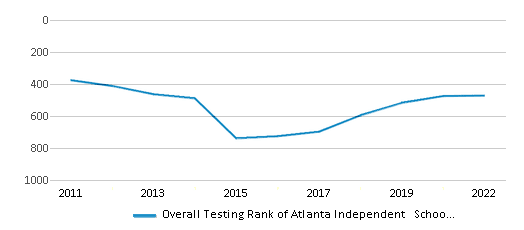
Math Test Scores (% Proficient)
40%
41%

Reading/Language Arts Test Scores (% Proficient)
55%
51%
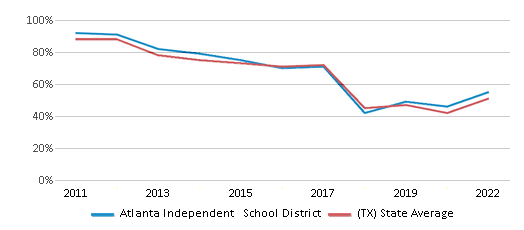
Science Test Scores (% Proficient)
48%
46%
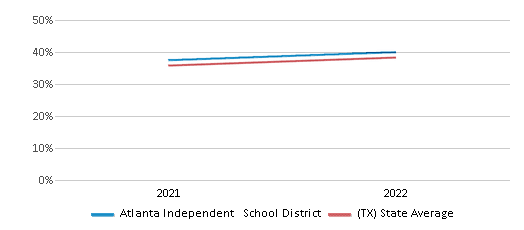
Graduation Rate
≥95%
90%
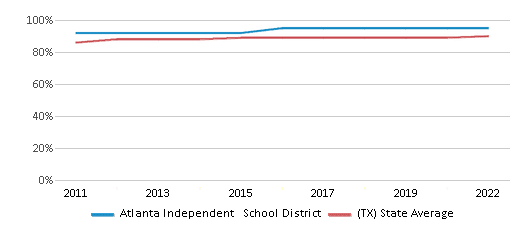
Students by Ethnicity:
Diversity Score
0.63
0.63
# American Indian Students
6 Students
6,302 Students
% American Indian Students
n/a
n/a
# Asian Students
11 Students
104,203 Students
% Asian Students
1%
5%
# Hispanic Students
181 Students
1,180,208 Students
% Hispanic Students
9%
55%
# Black Students
573 Students
275,255 Students
% Black Students
30%
13%
# White Students
1,011 Students
509,082 Students
% White Students
53%
24%
# Hawaiian Students
2 Students
3,291 Students
% Hawaiian Students
n/a
n/a
# Two or more races Students
142 Students
73,077 Students
% of Two or more races Students
7%
3%
Students by Grade:
# Students in PK Grade:
126
275,832
# Students in K Grade:
136
307,607
# Students in 1st Grade:
148
310,480
# Students in 2nd Grade:
166
317,113
# Students in 3rd Grade:
142
300,451
# Students in 4th Grade:
140
295,281
# Students in 5th Grade:
153
258,890
# Students in 6th Grade:
157
33,806
# Students in 7th Grade:
127
14,241
# Students in 8th Grade:
128
12,959
# Students in 9th Grade:
130
7,002
# Students in 10th Grade:
120
6,366
# Students in 11th Grade:
135
5,781
# Students in 12th Grade:
118
5,609
# Ungraded Students:
-
-
District Revenue and Spending
The revenue/student of $14,026 is higher than the state median of $13,387. The school district revenue/student has stayed relatively flat over four school years.
The school district's spending/student of $12,298 is less than the state median of $14,116. The school district spending/student has stayed relatively flat over four school years.
Total Revenue
$27 MM
$74,029 MM
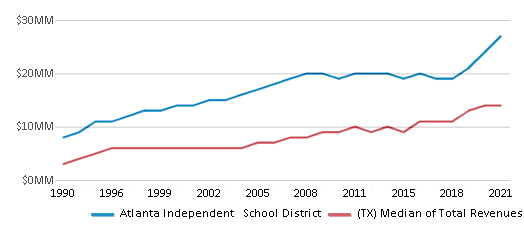
Spending
$24 MM
$78,063 MM

Revenue / Student
$14,026
$13,387

Spending / Student
$12,298
$14,116

Best Atlanta Independent School District Public Preschools (2025)
School
(Math and Reading Proficiency)
(Math and Reading Proficiency)
Location
Grades
Students
Rank: n/an/a
505 Rabbit Blvd
Atlanta, TX 75551
(903) 796-8115
Atlanta, TX 75551
(903) 796-8115
Grades: PK-2
| 576 students
Recent Articles

What Is A Charter School?
Explore the world of charter schools in this comprehensive guide. Learn about their history, how they operate, and the pros and cons of this educational innovation. Discover key facts about charter schools, including admission policies, demographics, and funding, as well as what to look for when considering a charter school for your child.

10 Reasons Why High School Sports Benefit Students
Discover the 10 compelling reasons why high school sports are beneficial for students. This comprehensive article explores how athletics enhance academic performance, foster personal growth, and develop crucial life skills. From improved fitness and time management to leadership development and community representation, learn why participating in high school sports can be a game-changer for students' overall success and well-being.

February 05, 2025
Understanding the U.S. Department of Education: Structure, Impact, and EvolutionWe explore how the Department of Education shapes American education, from its cabinet-level leadership to its impact on millions of students, written for general audiences seeking clarity on this vital institution.





